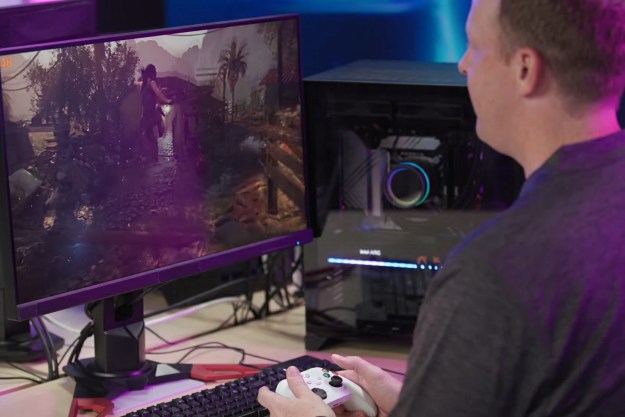XeSS is an a supersampling feature for Intel’s upcoming Arc Alchemist graphics cards. We’ve known since it was announced that the feature will work across recent Intel and Nvidia graphics cards, and now AMD has confirmed that its most recent cards will be able to accelerate the supersampling instructions, too.
For background, XeSS is coming in two versions. One will leverage Xe Matrix Extension (XMX) on Intel Arc graphics cards to upscale the image, while the other will use DP4a instructions. Nvidia has supported DP4a on its GPUs for the last three generations. Up till now, it hasn’t been clear if AMD cards support the instruction set, too.

In a comment to Computer Base, AMD confirmed that RX 6000 cards support DP4a, meaning they’ll work with XeSS. Unfortunately, AMD’s most recent cards are the cutoff point. The RX 5000-series and older Vega or Polaris cards don’t support DP4a instructions, so they won’t work with XeSS.
For Nvidia, XeSS supports more graphics cards than even Nvidia’s own Deep Learning Super Sampling (DLSS). DLSS requires an RTX graphics card, restricting it to the RTX 20-series and 30-series. XeSS works with these generations, as well as GTX 10-series
Intel’s latest cards will support the feature, but also recent integrated GPUs. The Xe LP architecture — found in the integrated graphics of mobile Tiger Lake chips — supports DP4a instruction. Older generations don’t, unfortunately.
It looks like Intel is establishing a nice middle-ground between DLSS and AMD’s FidelityFX Super Resolution (FSR). DLSS is highly restrictive, but it takes advantage of dedicated hardware to produce a better-looking image once the dirty upscaling work is done. FSR doesn’t look as good, and it’s based on much simpler tech, but it works with most graphics cards.
XeSS doesn’t support as many GPUs as FSR, but it doesn’t need to. It supports the most recent graphics cards from all major vendors, including better support for Nvidia GPUs than even Nvidia offers. FSR works with a wider range of cards, but it sounds like XeSS is something much more involved, more akin to DLSS in terms of quality.
We should point out that DP4a is uncharted territory for this kind of supersampling tech. The DP4a instruction set is mostly used to accelerate artificial intelligence (A.I.) calculations, but you shouldn’t confuse it with dedicated A.I. accelerators such as XMX or Nvidia’s Tensor cores. These accelerators are at the heart of XeSS and DLSS, respectively.

Intel has confirmed a “smart” trade-off in quality and performance with the DP4a version. There’s a difference, but we don’t know how significant that difference is. Given that XeSS uses machine learning, even the DP4a version should produce a better result than FSR, but we don’t know at this point.
Between XeSS and support for hardware-accelerated ray tracing, Intel is positioning itself to challenge Nvidia and AMD in a big way. The features are right, but we still don’t have any indication about how Arc Alchemist cards or XeSS will perform. It will be an interesting three-way battle once the cards show up in early 2022.
Editors' Recommendations
- In 2024, there’s no contest between DLSS and FSR
- AMD FSR (FidelityFX Super Resolution): everything you need to know
- AMD previews FSR 3.0, which now includes frame generation
- What is Intel XeSS, and how does it compare to Nvidia DLSS?
- Intel XeSS is already disappointing, but there’s still hope




